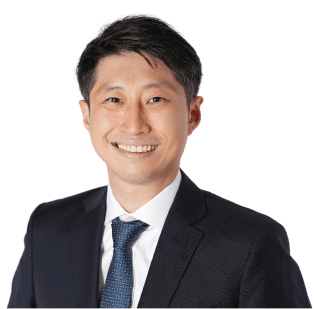TMJ Disorder

What is a TMJ Disorder?
The TMJ, or temporomandibular joint, is the joint that connects your lower jaw to your skull. Each person has two TMJs, one on each side of the face, positioned just in front of the ears. Without them, tasks like talking, chewing and swallowing would be impossible!
These joints play a vital role in every day jaw movements, including moving the jaw up and down, side to side, and forward and backwards. They are among the most complex and frequently used joints in the body, and thus are subjected to significant pressure daily.
TMJ disorders refer to a range of conditions that cause pain and dysfunction in and around the TMJ area and are also known as temporomandibular disorder (TMD). The pain ranges from sharp and intense (acute) to persistent and long-lasting (chronic), affecting other areas, including the head, neck and even the ears. Long standing headaches or migraines may be linked to TMJ disorder.
of TMD is due to stress
of those with TMD experience pain
of those affected are women
.png?width=640&height=800&name=original%20(1).png)
What Causes TMJ Disorder?
Identifying the exact causes of TMJ disorder can be challenging due to the intricate nature of the joint. However, the disorder may arise when during joint movement, there's a mismatch or dysfunction in several key components, that is:
- The joint - The TMJ consists of a complex system of bones, cartilage and ligaments that work together to enable smooth jaw movement. Any issues with these structures can contribute to TMJ disorder.
- The muscles - Stress, tension or overuse of head and neck muscles can lead to muscle spasms or tightness, contributing to TMJ disorder.
- The teeth - Problems with the alignment of the teeth or the way the upper and lower teeth fit together can put stress on the TMJ, leading to dysfunction and pain.
Advantages of TMJ Disorder Treatment

TMJ disorder can cause significant jaw pain, headaches and earaches.
Treatment aims to alleviate these symptoms through various methods that are aimed at reducing inflammation and improving jaw alignment, TMJ disorder treatment therefore provides relief from pain and discomfort.
TMJ disorder can affect the way the jaw moves, making it difficult to chew, speak or open the mouth fully.
Treatment helps address these issues by restoring proper jaw alignment and muscle function. This can improve the range of motion and overall function of the jaw.
Untreated TMJ disorder can lead to further damage to the jaw joint and surrounding tissues.
By addressing the issue early and implementing appropriate treatment, further damage can be prevented, preserving the health of the jaw joint.
Patients with TMJ disorders often rely on medications such as pain relievers, muscle relaxants or anti-inflammatories to manage their symptoms. However, long-term use of these medications can have side effects and be costly over time.
TMJ disorder treatment aimed at improving jaw function potentially eliminates the need for ongoing medication management.
TMJ disorder can significantly impact a person's quality of life, affecting their ability to eat, speak and even sleep comfortably.
By effectively managing the condition, treatment can improve overall quality of life by reducing pain and discomfort associated with TMJ disorder.
The TMJ Trouble-Makers: 6 Things That Worsen The Pain
While you may not have complete control over all the factors that contribute to TMJ disorder, you can take steps to both treat pain and prevent activities that exacerbate the condition. The following habits might worsen the pain: he following habits might worsen the pain:
Using your teeth for tasks other than chewing
Maintaining poor posture
Chewing gum excessively
Teeth grinding habit
Sleeping on your stomach
Taking large bites of food
TMJ Disorder Treatment: Is it for me?
TMJ disorder can manifest differently in each person, so not everyone will experience all the same symptoms. It is advised to seek treatment if you experience symptoms of TMJ such as:

Pain in the face, neck or jaw joint area, worsened by jaw movements

Stiffness or difficulty in opening or closing the mouth

Clicking, popping or locking sensation in the jaw joint

Frequent headaches and earaches

Feeling tired or weariness in the face
.png?width=61&height=61&name=image%20263%20(1).png)
Change in your bite, with worn or cracked teeth
Feature
Number of implants needed
Implant placement
Implant angulation
Need for bone grafting and other surgical procedures like sinus lift and nerve repositioning
Treatment timeline
Traditional Implants
Requires one implant for each missing tooth
Implants have to be placed where the individual tooth is missing
Align with adjacent teeth and supporting bone
High probability, especially if sufficient bone is not present to support the implant, or vital structures like nerves and sinus membrane are in close proximity
Have to wait for a healing period of 3-6 months before artificial teeth can be placed
All-on-4 Implants
Requires 4 implants to replace an entire jaw of missing teeth
Implants are strategically placed in areas of jawbone with the highest bone density
Two implants at the back are placed at 30-45 degrees
Less probability of requiring adjunct surgical procedures
You receive your temporary artificial teeth immediately after placement of the implants
What It Means If You Choose All-on-4
Overall cost of treatment is reduced
Stable implants and artificial teeth
Stress from daily activities such as chewing and swallowing is distributed efficiently
Overall cost of treatment is reduced, less recovery time and less stress for patient
Patient receive their new teeth on the same day as surgery
Feature
Number of implants needed
Implant placement
Implant angulation
Need for bone grafting and other surgical procedures like sinus lift and nerve repositioning
Treatment timeline
Traditional Implants
Requires one implant for each missing tooth
Implants have to be placed where the individual tooth is missing
Align with adjacent teeth and supporting bone
High probability, especially if sufficient bone is not present to support the implant, or vital structures like nerves and sinus membrane are in close proximity
Have to wait for a healing period of 3-6 months before artificial teeth can be placed
All-on-4 Implants
Requires 4 implants to replace an entire jaw of missing teeth
Implants are strategically placed in areas of jawbone with the highest bone density
Two implants at the back are placed at 30-45 degrees
Less probability of requiring adjunct surgical procedures
You receive your temporary artificial teeth immediately after placement of the implants
What It Means If You Choose All-on-4
Overall cost of treatment is reduced
Stable implants and artificial teeth
Stress from daily activities such as chewing and swallowing is distributed efficiently
Overall cost of treatment is reduced, less recovery time and less stress for patient
Patient receive their new teeth on the same day as surgery
Managing TMJ Disorders
Treatment for TMJ disorder is tailored to individual needs, considering factors like the underlying cause, symptom severity and overall health. Initially, noninvasive options are typically recommended. If these are ineffective, surgery may be advised to repair or replace damaged joint components.
.png?width=100&height=100&name=Frame%20732%20(4).png)
Lifestyle Changes
Avoiding hard or chewy foods can lessen strain on the jaw muscles and joints. Practising relaxation techniques can reduce jaw clenching while improving body posture can help alleviate pressure on the jaw.

Medications
Over-the-counter pain relievers help reduce facial pain and discomfort associated with TMJ disorder. NSAIDs may be recommended to reduce inflammation in the jaw joint. Additionally, muscle relaxants benefit individuals who grind their teeth, helping to relax the jaw muscles.
.png?width=101&height=100&name=Frame%20732%20(5).png)
Dental Treatment
Mouth guards or splints are commonly used to reduce teeth grinding and jaw clenching in individuals with TMJ disorder. Dental procedures such as bite adjustments has also shown to be effective in improving jaw alignment, which may alleviate TMJ-related symptoms.
-1.png?width=80&height=80&name=image%20240%20(1)-1.png)
Physical Therapy
Exercises to stretch and strengthen the jaw muscles, as well as techniques to improve jaw mobility, can be beneficial.
.png?width=101&height=101&name=Frame%20732%20(16).png)
Counselling
Counseling can help individuals identify and address underlying stressors or emotional factors that may contribute to jaw clenching and TMJ symptoms.

Surgery
In severe cases, surgery may be recommended to repair or replace the jaw joint, but this is typically considered a last resort.
.png?width=100&height=100&name=Frame%20732%20(4).png)
Lifestyle Changes
Avoiding hard or chewy foods can lessen strain on the jaw muscles and joints. Practising relaxation techniques can reduce jaw clenching while improving body posture can help alleviate pressure on the jaw.

Medications
Over-the-counter pain relievers help reduce facial pain and discomfort associated with TMJ disorder. NSAIDs may be recommended to reduce inflammation in the jaw joint. Additionally, muscle relaxants benefit individuals who grind their teeth, helping to relax the jaw muscles.
.png?width=101&height=100&name=Frame%20732%20(5).png)
Dental Treatment
Mouth guards or splints are commonly used to reduce teeth grinding and jaw clenching in individuals with TMJ disorder. Dental procedures such as bite adjustments has also shown to be effective in improving jaw alignment, which may alleviate TMJ-related symptoms.
-1.png?width=80&height=80&name=image%20240%20(1)-1.png)
Physical Therapy
Exercises to stretch and strengthen the jaw muscles, as well as techniques to improve jaw mobility, can be beneficial.
.png?width=101&height=101&name=Frame%20732%20(16).png)
Counselling
Counseling can help individuals identify and address underlying stressors or emotional factors that may contribute to jaw clenching and TMJ symptoms.

Surgery
In severe cases, surgery may be recommended to repair or replace the jaw joint, but this is typically considered a last resort.
Treatment Options for TMD
Mouthguards can provide therapy for the jaw joint and relieve pain and TMD symptoms. As nightguards that are soft and thick can worsen the symptoms of TMD, when selecting a mouthguard or nightguard, aim for one that promises optimal results by adhering to these critical guidelines:
- Ensure it is shaped based on an analysis of your bite so that your jaw is in a rest position while wearing the mouth guard
- It must fit snugly against your teeth as any looseness can cause more muscle activity
- The material must be sturdy and rigid and not soft or too flexible as that can worsen TMD
- It must be strong to be durable while not being too thick to ensure comfort and prevent overopening of the TMJ joint without sacrificing protection
.png?width=525&height=525&name=Rotate%20-90%20degree%20(12).png)
The Kois Deprogrammer, created by Dr. John C. Kois works by preventing teeth from interlocking, allowing the jaw to find its ideal position. Patients might wear it from a week to a month to reset muscle memory, achieving a natural bite in harmony with the jaw muscles.
This works for immediate relief in acute episodes of jaw pain or TMD where there is intense jaw pain and inability to chew. Once the pain is relieved, a bite assessment can be carried out to determine the cause of TMD and treatment can include full mouth rehabilitation treatment in patients with worn out teeth or Invisalign treatment if the TMD is due to imbalanced bite.


Treatment Options for TMD
Mouthguards can provide therapy for the jaw joint and relieve pain and TMD symptoms. As nightguards that are soft and thick can worsen the symptoms of TMD, when selecting a mouthguard or nightguard, aim for one that promises optimal results by adhering to these critical guidelines:
- Ensure it is shaped based on an analysis of your bite so that your jaw is in a rest position while wearing the mouth guard
- It must fit snugly against your teeth as any looseness can cause more muscle activity
- The material must be sturdy and rigid and not soft or too flexible as that can worsen TMD
- It must be strong to be durable while not being too thick to ensure comfort and prevent overopening of the TMJ joint without sacrificing protection
The Kois Deprogrammer, created by Dr. John C. Kois works by preventing teeth from interlocking, allowing the jaw to find its ideal position. Patients might wear it from a week to a month to reset muscle memory, achieving a natural bite in harmony with the jaw muscles.
This works for immediate relief in acute episodes of jaw pain or TMD where there is intense jaw pain and inability to chew. Once the pain is relieved, a bite assessment can be carried out to determine the cause of TMD and treatment can include full mouth rehabilitation treatment in patients with worn out teeth or Invisalign treatment if the TMD is due to imbalanced bite.

Curious About Root Canal Treatment in Singapore?
Grab our free root canal treatment guidebook
Process of Getting TMJ Disorder Treatment at
Dental Designs in Singapore
.png?width=370&height=341&name=Rectangle%2053%20(12).png)
1. TMJ Disorder Consultation
Our dentist will start by discussing your dental needs and gathering information about your medical history, including any previous injuries or conditions that may be relevant. They will also inquire about any medications you are currently taking, as some medications can affect jaw health.
You may be asked to describe your symptoms, such as any pain or discomfort in the jaw, face or neck. You may also discuss any clicking, popping or grinding sounds when you move your jaw.
To plan your treatment effectively, we will take x-rays of your teeth, considering every possibility. It’s important to us that you feel informed and confident about your options.
-2.webp?width=371&height=341&name=Rectangle%2053%20(1)-2.webp)
2. TMJ Examination
A detailed TMJ examination will be conducted to evaluate the function of your jaw joints and muscles, including:
- Physical Examination: The dentist will examine your jaw joints, muscles and bite. They will check for tenderness, swelling or abnormalities in the jaw joint area. Your jaw's range of motion will also be assessed by asking you to open and close your mouth, move your jaw from side to side and perform other movements.
- Dental Examination: Your teeth will be examined for signs of teeth grinding or clenching, which can contribute to TMJ disorder. The dentist will also assess your bite to determine if there are any alignment issues that could be causing jaw problems.

3. Management and Treatment
Following the examination, your dentist will carefully review the results to determine the most suitable treatment plan for your TMJ disorder. Treatment options may include:
-
Lifestyle modifications
-
Pain management strategies
-
Dental appliances such as mouth guards or splints
-
In more severe cases, surgery may be recommended
It's important to note that self-diagnosis and treatment for TMJ disorder are not recommended, as every patient's condition is unique. Your dentist will work with you to develop a personalised treatment plan that addresses your specific needs and provides the best possible outcome for managing your TMJ disorder.
.png?width=370&height=341&name=Rectangle%2053%20(18).png)
4. Review Check
Follow-up appointments are an essential part of managing TMJ disorder effectively. These appointments allow your dentist to monitor your progress, make any necessary adjustments to your treatment plan and ensure that your TMD symptoms are being managed optimally.
Early detection and appropriate treatment can help alleviate symptoms and improve the overall quality of life for individuals with TMJ disorder. Regular follow-up appointments play a crucial role in achieving these goals.
Meet Our Doctors and Dental Lab Team Behind TMJ Disorder Treatment
Cost of TMJ Disorder Treatment in Singapore
The cost can vary significantly and is based on the treatment plan developed by the dentist for each patient. At Dental Designs, we offer a range of custom-designed dental appliances to alleviate TMJ disorder symptoms.
One such appliance is the Kois Deprogrammer, which works by preventing the upper and lower teeth from interlocking, thereby allowing the jaw muscles to relax. This appliance helps reposition the jaw to a more stable and comfortable alignment. The price for one starts from $436.
Additionally, we offer mouth guards for TMJ therapy. The Dura3D mouth guard offers enhanced strength through 3D printing technology. For heavy teeth grinders, the DuraMax mouth guard provides durability but comes at a higher price due to its precision-milled construction. Both of these options are suitable for patients suffering from TMJ disorders as they are bite fitted and durable and not bulky unlike regular mouthguards.
During your consultation, your dentist will assess your specific needs and provide you with a detailed breakdown of the costs involved, enabling you to make an informed decision about your treatment and budget accordingly.
Starts From
$436*
| Kois Deprogrammer | $436 |
| Dura3D Mouth Guard | $779.35 |
| DuraMax Mouth Guard | $997.35 |
*Price are inclusive of 9% GST
Hear From Our Happy Patients
The service and doctor is the best in town! The customer service and receptionists are very friendly! Dr Phillip Miller and Dr Noah Teo is very nice and very professional on their skill! They also very patient to explain to me about the treatment!
Will come back again!
Thank you very much!
李岳侨
J. Kho
This dental clinic has very good staff who are well trained and friendly. The dentists are also very good and will explain the treatment in detail before starting treatment. The equipment is very high tech and I believe they are able to do high quality work as I did my crown here and it looks much better than my colleague who also recently did his at another place. The waiting room is also very comfortable. good job!
C. Zheng De
This clinic is one of the best I have ever seen. I saw dr Justin for my implant which I did many years ago, the tooth was loose, and other drs told me to remove it as they could not find out what brand it was but dr Justin was able to take 3d xrays and locate the brand and specially ordered the part in. he saved me from having to do a surgery to remove and put a new implant which would have cost me a bomb. the tooth looks even better than the original thanks to the experieced dental technician Katsuya from Japan.
Very happy and will keep coming back for my regular dental.
G. Hock An
my workplace is close by and I had a problem with my tooth for a few days, so I made an appointment to come down. The receptionist who booked my appointment was very helpful and friendly to explain the way to the clinic from my office. I saw Dr Nicholas who was able to do a root canal treatment on the same visit so that I didn't need to come back. I felt safe and comfortable to do my dental treatment here as the dental picks are all wrapped up and sterilized and only opened before each treatment when im inside.
P. Wendy
Creating Smiles, Changing Lives
Over 28 reviews
The service and doctor is the best in town! The customer service and receptionists are very friendly! Dr Phillip Miller and Dr Noah Teo is very nice and very professional on their skill! They also very patient to explain to me about the treatment!
Will come back again!
Thank you very much!
李岳侨
J. Kho
This dental clinic has very good staff who are well trained and friendly. The dentists are also very good and will explain the treatment in detail before starting treatment. The equipment is very high tech and I believe they are able to do high quality work as I did my crown here and it looks much better than my colleague who also recently did his at another place. The waiting room is also very comfortable. good job!
C. Zheng De
This clinic is one of the best I have ever seen. I saw dr Justin for my implant which I did many years ago, the tooth was loose, and other drs told me to remove it as they could not find out what brand it was but dr Justin was able to take 3d xrays and locate the brand and specially ordered the part in. he saved me from having to do a surgery to remove and put a new implant which would have cost me a bomb. the tooth looks even better than the original thanks to the experieced dental technician Katsuya from Japan.
Very happy and will keep coming back for my regular dental.
G. Hock An
my workplace is close by and I had a problem with my tooth for a few days, so I made an appointment to come down. The receptionist who booked my appointment was very helpful and friendly to explain the way to the clinic from my office. I saw Dr Nicholas who was able to do a root canal treatment on the same visit so that I didn't need to come back. I felt safe and comfortable to do my dental treatment here as the dental picks are all wrapped up and sterilized and only opened before each treatment when im inside.
P. Wendy
Google Rating
Based on 1000+ Google reviews
Frequently Asked Questions about TMJ Disorder Treatment in Singapore
TMD disorder is a complex condition with diverse manifestations and numerous underlying causes. In fact, there are over thirty types of TMJ disorders, which can be broadly classified as
- Disorders of the jaw joints
- Disorders of the chewing muscles
- Headaches resulting from TMD
It is important to note that within each of these categories, there are various specific disorders and conditions that can affect the TMJs, muscles and surrounding structures. Each individual's presentation of TMJ disorder can be unique and treatment approaches are often tailored to address their specific symptoms and underlying causes.
Yes, there is a difference between the terms TMJ and TMD:
-
TMJ (Temporomandibular Joint): TMJ refers to the actual joint where the lower jaw connects to the skull. It is a complex joint that allows for jaw movement during activities like chewing, talking and yawning.
-
TMD (Temporomandibular Disorder): TMD is a broader term that refers to a group of conditions that affect the TMJ and the muscles surrounding it. TMD is also known as TMJ Disorder.
TMD encompasses a range of problems related to the jaw joint, jaw muscles and associated structures. These problems can cause pain, discomfort and dysfunction in the jaw joint and muscles.
In summary, TMJ is the joint itself while TMD is the term used to describe disorders or issues affecting the TMJ and related structures.
In some cases, mild jaw joint pain may resolve on its own with rest, self-care measures and avoidance of aggravating factors. However, persistent or severe jaw joint pain should not be ignored, as it can indicate an underlying issue that may require treatment.
If you are experiencing jaw joint pain, it is advisable to consult with a dentist. They can assess your symptoms, determine the underlying cause of your jaw joint pain and recommend appropriate treatment options.
Get in Touch
We’d love to hear from you!
Schedule Appointment
Directly with our Online Booking Form












